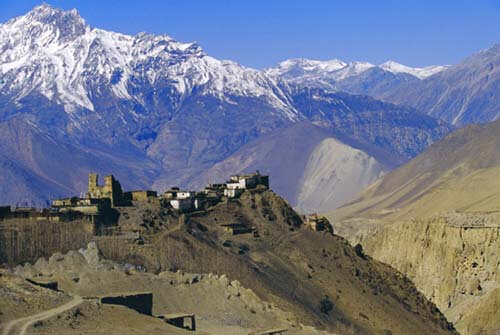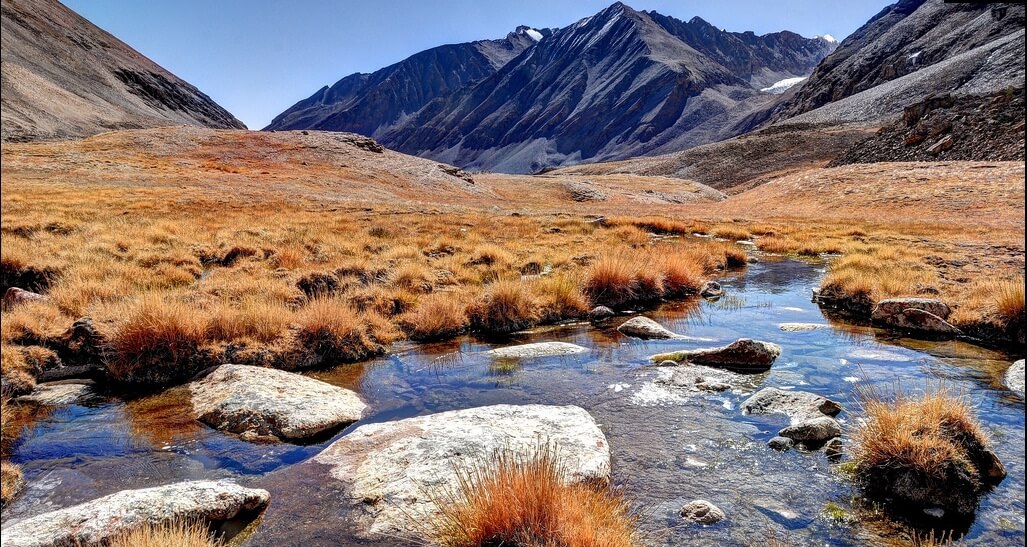Upper Mustang Trekking
 Upper Mustang trekking is one of Nepal's most mysterious and least known kingdoms. The landscape of Mustang is a barren moonscape of eroded sandstone pillars and discontinuous moraine terraces, which together present a colorful mosaic made up principally of earthen reds, yellows and brown. It is relatively easy trekking along the permitted route to Lo Manthang, which lies in the very heart of Mustang. The trek to Mustang is through an almost treeless barren landscape. Strong winds generally howl across the area in the afternoon, generally subsiding at night. Being in the rain shadow of the Himalaya, Mustang has much less rain then the rest of Nepal.
Upper Mustang trekking is one of Nepal's most mysterious and least known kingdoms. The landscape of Mustang is a barren moonscape of eroded sandstone pillars and discontinuous moraine terraces, which together present a colorful mosaic made up principally of earthen reds, yellows and brown. It is relatively easy trekking along the permitted route to Lo Manthang, which lies in the very heart of Mustang. The trek to Mustang is through an almost treeless barren landscape. Strong winds generally howl across the area in the afternoon, generally subsiding at night. Being in the rain shadow of the Himalaya, Mustang has much less rain then the rest of Nepal.
Upper Mustang trekking lying in the rain shadow of the Himalayas is perhaps the last enclave of pristine Tibetan culture. Forbidden & isolated from the rest of the World it was able to evolve its own distinctive culture and traditional which is so rich & unique. Lo-Mustang, the capital is walled city ruled by religious king. Untouched by modern civilization, life in Mustang goes on as it has for centuries in unhurried pace. As everywhere in the Himalayas, this area provides spectacular mountain scenery highlighted by Dhaulagiri at 8167 meters (26,795ft) and Annapurna I at 8091 meters (26,545ft). You will be surrounded by more than 35 mountains over 6000 meters (19,680ft) high. The elevation of the the trails rise from 2815 meters (9,233ft) to 3780 meters (12,398ft) above sea level.
Day 1: Arrive Kathmandu
Arrive at Kathmandu after a scenic flight over the mountains and transfer to Hotel.
Day 2: Explore the city and prepare for the trek.
Full day sightseeing world heritage sites in Kathmandu valley (Swayambhunath Temple, Kathmandu Durbar Square, Pasupatinath Temple and Bouddhanath Stupa) for some time and prepare for the trek in the afternoon.
Day 3: Drive to Pokhara.
After breakfast we will take a scenic bus drive Pokhara. Walk around the lake side and explore Pokhara city on your own. You can have an excellent view of the mountains as they are only 28 Kms away from Pokhara city, which lies at an altitude of 900m.
Day 4: Fly to Jomsom (2700m) and trek to Kagbeni (2810m)
Early morning breakfast and fly to Jomsom early in the morning to avoid the wind in the afternoon. After landing at the Jomsom airport we will start trekking to Kagbeni following the Kali Gandaki River. The trail goes along the back of the Kaligandaki River, is flat and has a very rough terrain. We will see the mountains Nilgiri, Dhaulagiri, Thorang peak and many more from the trail, in the backdrop. After two hours of walk in the flat land along the bank of Kaligandaki, we reach Kagbeni. O/N at Kagbeni..
Day 5: Kagbeni to Chuksang (2900m)
After breakfast we will leave lower Mustang and enter Upper Mustang. After walking for some time we can see the Gompa Kang and numerous caves in the west. At Tangbe we will get a good opportunity to stretch our legs and try our stamina as we climb up to 3060m.Tangbe is a labyrinth of narrow alleyways; here you will find the typical Mustang chortens painted in black white and red. After 1 hour of further walking we reach the village of Chuksang, where there is majority of Thakali people but they live in harmony with the Bhotias and Gurungs. O/N at Chuksang.
Day 6: Chuksang to Samar (3150m)
After breakfast trek to Samar. It takes around 4-5 hours and the day is not very tiring so you can take frequent breaks to interact with the villagers and take pictures. Villages become more scattered as you enter deeper into the region, life becomes more basic and the landscape more arid. You leave the valley today and climb steeply up to Chele home to a number of ferocious Tibetan Mastiffs, thankfully chained to the village houses. You continue up on the side of a steep canyon to a pass after which you then descend on a pleasant trail to Samar, situated in a grove of Poplar trees. O/N at Samar.
Day 7: Samar to Geling (3510m)
After breakfast, We will start to ascend from Samar and in half an hour we reach a ridge which leading into a gorge and another valley full of juniper trees. We continue walking and cross the small river and reach the base of the Shyangmochen, a tiny settlement with a few local facilities. Near Shyangmochen is the Rangbyung which has stalagmites which look like small chortens, making it one of the most sacred places in whole Mustang. Climbing up is over for today as we gently get down to Geling, which has small population living in small mud houses. At the end of the day we should have walked around 5 hours. O/N at Geling
Day 8: Geling to Ghami (3490m)
After breakfast, We start a 5 1/2 hours walk to Ghami. The walking duration seems short but is has lots of climbs making it difficult to catch pace. The climb begins steadily to the centre of the valley and then around to the head of the valley, to the Nyi La passes (3840m). After crossing the pass we, as previous day we will gently start walking down to reach Ghami, a large white-washed village sheltered by the overhanging cliffs. O/N at Ghami.
Day 9: Ghami to Charang (3620m)
After breakfast, trek to Charang.Today is the hardest in the entire trip so make sure you have enough water and some power bars to Support you as we walk past the driest place in the Mustang area. The walk might be tiring and 5 hours might seem as long as 10 but still you can feel fresh with the view of the high mountains in the backdrops. At mid afternoon we will reach Charang, where at the eastern end a huge Dzong (fortress) and red gompa home to a great collection of statues and thankas can be seen. O/N at Charang.
Day 10: Charang to Lo Manthang (3840m)
After breakfast trek to Lo Manthang. Only 3 hours walking distance. May be a lazy morning as well and then leave Charang and head up the valley to the boundary between Charang and Lo, the trail here broadens and soon you will catch sight of Lo Manthang, with only one entrance you will walk round to the North East corner to get in. O/N At Lo Manthang.
Day 11: Explore Lo Manthang
There are no rigid facts but it is said that this city was already in existence before 1390 and Ama Pal, was the person responsible for constructing this beautiful town in the cold desert. The last king of Lo Manthang was Jigme Dorje Palbar Bista (born c. 1933), and was the 25th King of Mustang from the Bista Dynasty. The people of Lo Manthang are known as Lhobas. The village is noted for its tall white washed mud brick walls, gompas and the Raja's or Royal or King's Palace, a nine-cornered, five story structures built around 1400. There are four major temples: Jampa Lhakhang or Jampa Gompa, the oldest, built in the early 15th century and also known as the "God house"; Thubten Gompa, a huge, red assembly hall and gompa built in the late 15th century and located just southwest of Jampa Gompa; Chodey Gompa, now the main city gompa; and the Choprang Gompa, which is popularly known as the "New Gompa". The Government opened access for tourist to this area after 1992, but still the tourism to Upper Mustang remains limited.
Day 12: Lo Manthang to Ghami (3490m)
After breakfast,we start the second leg of the journey to get back to Jomsom. We take the same way back to Ghami. There are few alternate routes but very short ending up at the main trail in short span of time. Overnight at Ghami.
Day 13: Ghami to Chuksang (2900m)
After breakfast, we will reach Chuksang after crossing the Kaligandaki and walking past some desert like land area. After walking for around 6 hours we reach Chuksang for overnight at Chuksang.
Day 14: Chuksang to Muktinath (3795m)
After breakfast trek start to Muktinath.You will travel through some pretty scenery today, apple orchards, agricultural fields and pretty villages. At the end of the day we can make a brief visit to the temple of Muktinath which is worshiped by Hindus as Lord Vishnu and By Buddhists as Avalokteshowrs. This temple premise has 108 stone spouts from where holy water comes throughout the day. O/N At Muktinath.
Day 15: Muktinath to Jomsom
After the short descend in the morning you will find yourself in Jharkot and Khingar, where there are beautiful monasteries which give you the opportunity to witness the interrelation and similarity of Tibet to this area. The view of Dhaulagiri and Nilgiri is splendid throughout the trail. We will walk past Kagbeni to reach Jomsom along the bank of kali Gandaki River. We can spend some time exploring the headquarter of the mustang district, Jomsom from where the Mountain View is magnificent.
Day 16: Fly to Pokhara
Early morning flight to Pokhara and free day at Pokhara for lunch and surrounding in Pokhara..
Day 17: Drive back to Kathmandu.
Day 18: Depart Kathmandu to reach another destination or fly back home with memories of the trek.
You can depart from Kathmandu to your home country or extend the trip and head for another trip within or outside Nepal
# All necessary transportation by Private Vehile.
# Hotel Accommodation Kathmandu/Pokhara on B/B basis
# All accommodation in Guest House or Lodge on full board basis ( Breakfast , Lunch, Dinner ) during trekking
# Airfare - Pokhara – Jomsom-Pokhara
# Guide, porter, etc…
# Trekking permit/ conservation fee/ Tims etc..
# Mustang Permit
Cost does not include:
# Lunch and Dinner in Kathmandu and Pokhara
# Domestic Airport tax.
# Insurance,
# personal expenses such as drink, Laundry, tips etc..







Connect With Us :